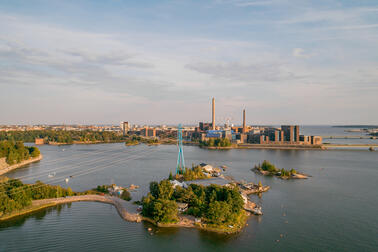
The City of Helsinki’s new environmental protection objectives were approved by the City Board in spring 2024. They show the way towards an ecologically sustainable future and set clear, measurable long-term goals for the consistent execution of environmental protection.
"The Environmental Report 2024 shows that Helsinki is taking responsibility for the environmental impact of the city's growth through its determined environmental protection programmes and practical actions. Helsinki’s medium- and long-term environmental protection objectives were updated during 2024, in addition to which the Baltic Sea Action Plan and Helsinki’s Air Quality and Noise Abatement Plan were also renewed," says Head of Environmental Affairs Miira Riipinen from the City of Helsinki.
Five new nature reserves were established in Helsinki in 2024. In future, Helsinki aims to significantly increase the number of nature reserves established each year. The City aims to protect 10% of both Helsinki’s land and water areas by 2038. The new Nature Reserve Programme will double the area of protected land and increase the area of the City's protected sea areas tenfold.
“Helsinki is characterised by the fact that nature is always close by and easily accessible, regardless of where in the city you live. Helsinki has also started to pay more attention to the quality of local nature. Reconciling construction activities with both nature conservation and a smaller carbon footprint is a major challenge that the City is determined to address,” says Head of Environmental Affairs Riipinen.
The City of Helsinki’s environmental and climate objectives also play a central role in early childhood education and schools. For example, last year the Sustainable Development Fox tour reached almost all primary schools in the city and approximately 2,900 pupils.
Helsinki also achieved its strategic goal of being the most sustainable tourist destination in the world by ranking first in the international Global Destination Sustainability (GDS) Index.
Transport expected to become the biggest source of emissions in 2025
The biggest reason for the strong decrease in emissions in 2024 was the cessation of coal burning in the Hanasaari power plant in spring 2023. Following the closure of the Salmisaari power plant in spring 2025, the use of coal ceased completely. This resulted in transport becoming the biggest source of emissions in Helsinki.
In 2024, the reduction in the use of coal and the shift to new solutions in heat production, such as heat pumps, reduced district heat emissions by 27% compared to the previous year.
Emissions from electricity consumption decreased by 14%, even though electricity consumption itself increased by 5% from the previous year.
Emissions from transport increased by 3% from the previous year. This is mainly due to a decrease in the bio share of transport fuels when compared to the previous year.
“With the use of coal for energy production coming to an end, Helsinki's climate work has reached a stage where transport is the biggest source of emissions. In order to achieve emission reduction targets, what we need now is a wide selection of measures that affect both the change in transport power sources and the reduction of mileage. The City will continue to invest heavily in electric vehicle charging infrastructure, rail transport and the development of pedestrian and cycling environments,” says Climate Director Hanna Wesslin from the City of Helsinki.
Public transport passenger volumes increased compared to the previous year, but did not recover to pre-COVID levels yet. Helsinki Region Transport (HSL) commissioned approximately 120 new electric buses, and nearly 42 per cent of kilometres driven on public transport buses were driven by electric buses. The number of electric cars continued to increase, with battery-powered cars accounting for 20.7% of all cars in traffic use (16.7% in 2023).
Compared to 1990, the total emissions of Helsinki were 54% lower. Direct emissions per capita were 2.4 tonnes of carbon dioxide equivalent (CO₂-eq.). They decreased by 18% from the previous year and were 67% lower than in 1990. According to the new draft city strategy, Helsinki aims to reduce emissions by 85% by 2030 from 1990 levels and achieve net zero emissions by 2040.
In 2024, Helen Ltd's share of energy produced with renewable energy was 38%. All in all, 63% of the energy produced by Helen was carbon neutral.
The Environmental Report details progress towards the City's environmental objectives
The annually published Environmental Report provides information on the progress towards the City's environmental protection objectives and the environmental impact of its activities. The report also monitors the implementation of key environmental protection programmes,
such as the Carbon Neutral Helsinki Action Plan, Helsinki’s climate change adaptation policies and the Action Plan for the Circular and Sharing Economy.
The Environmental Report will be presented to the Helsinki City Board on Monday 11 August. The City Council will process the report on 27 August 2025.


